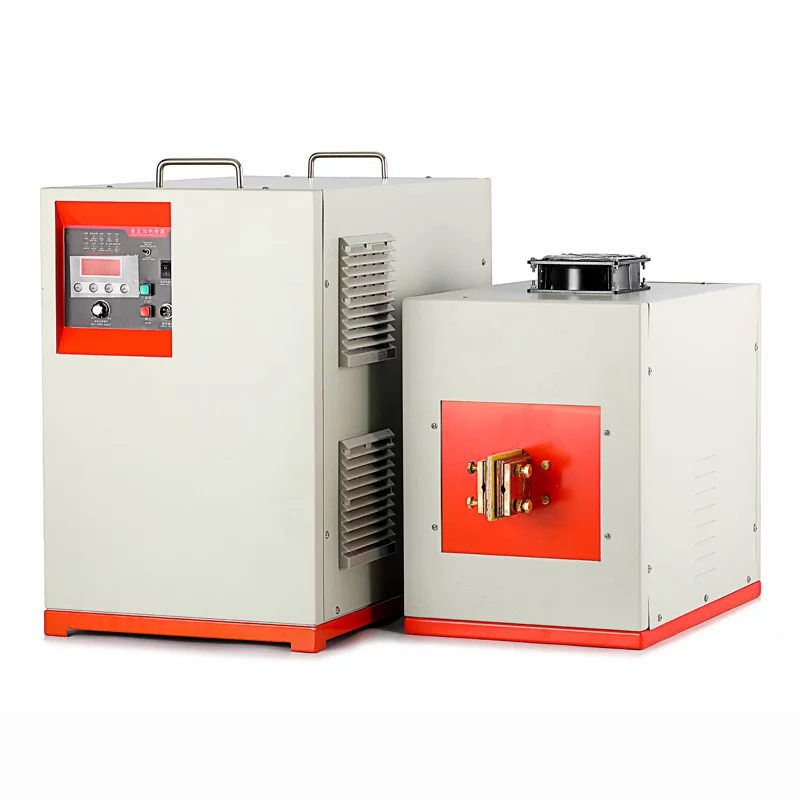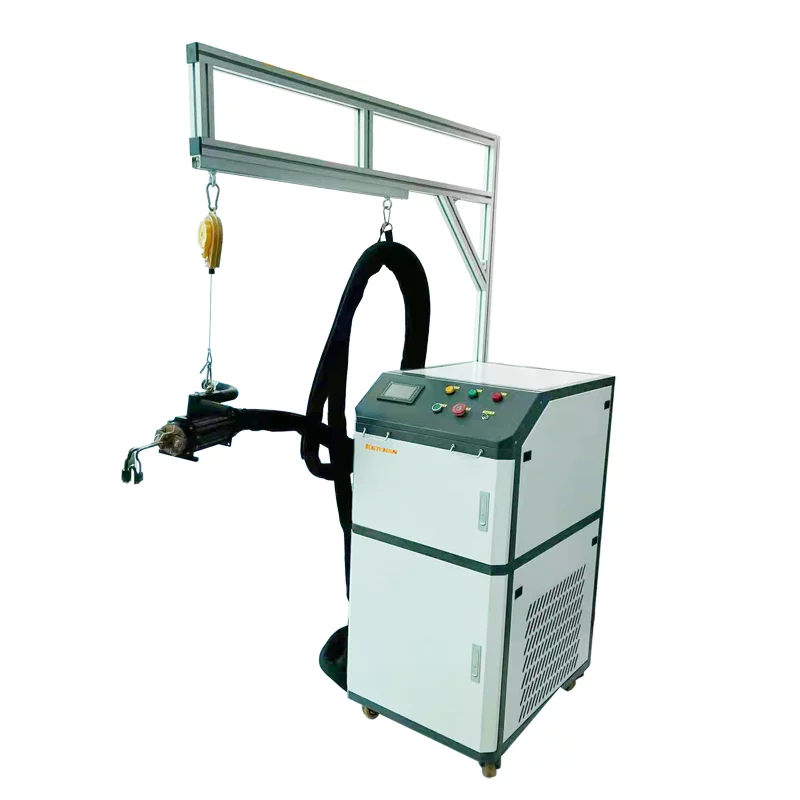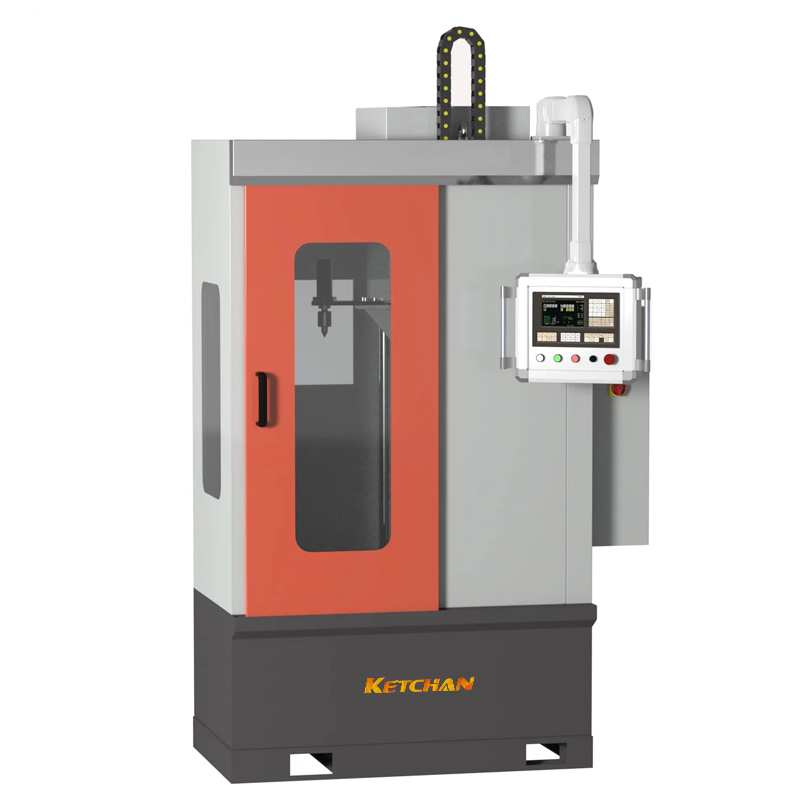There are two ways of high frequency quenching induction heating: the first is simultaneous heating and quenching, that is, the surface of the workpiece that needs to be quenched is heated at the same time, followed by sharp cooling; The second is sequential quenching, that is, by induction heating a small part of the surface of the workpiece, while the workpiece is moved from top to bottom so that the surface successive heating and cooling.
In the production of multi-variety and small-batch parts, different materials may need to use different quenching medium, so the quenching method of simultaneous heating is mostly adopted. If the parts with large quenching surface areas are limited by equipment power and other factors, continuous heating is considered for quenching.
1. High frequency surface quenching of the inner hole of the martensitic stainless steel workpiece
(1) Processing difficulties
The high frequency surface quenching of the inner hole of the martensitic stainless steel workpiece adopts the way of simultaneous heating, the processing difficulty lies in the quenching of the stainless steel material and the inner hole surface.
In the process of high-frequency induction heating, when the temperature exceeds the material’s demagnetization point (the temperature of iron and steel’s demagnetization point is generally 700 ~ 800℃), the material’s electromagnetic induction ability decreases, and the heating speed drops several times, making further heating difficult. And stainless steel heat treatment temperature is high, are above 1000℃, heating to the quenching temperature of the material is more difficult. On the other hand, due to its high heat treatment temperature, close to the melting point of the material, although the heating speed above the loss of magnetic point is reduced, the heating speed is still faster than the conventional heat treatment, and difficult to control, there is a risk of surface overheating and melting parts.
The annular effect is one of the three main effects of induction heating and is also the reason for the difficulty of inner hole heating. When the workpiece is heated by the induction coil, the current passing through the induction coil is concentrated on the inner surface of the induction coil. When heating the outer surface of the workpiece, the inner surface of the induction coil should be relative to the outer surface of the workpiece, which is conducive to the heating of the workpiece, while when heating the surface of the inner hole of the workpiece, the direction is just opposite, which will significantly reduce the electrical efficiency of the inductor and is not conducive to the heating of the workpiece. Moreover, when the inner hole induction quenching is carried out, the heating surface is inside the workpiece, so it is not easy for the operator to observe directly from the outside, which increases the operation difficulty to a certain extent.
The spherical bearing of some product requires sf28mm spherical quenching, the material is martensite stainless steel 20Cr13, quenching hardness requires 35 ~ 45HRC.In addition to the above heating difficulties, the heating surface of the workpiece is spherical instead of straight through the inner hole, which will inevitably cause the gap between the sensor and the workpiece heating surface to increase, further reducing the electrical efficiency. In order to overcome the adverse effect of the annular effect on the workpiece heating, magnetic conductivity is set on the inductor to change the distribution of the magnetic field and force the electric flow direction to be close to the surface distribution of the workpiece to be heated, so as to improve the heating effect. However, the inner hole of the workpiece is small, so the gap distance between the sensor and the workpiece and the size of the sensor itself is removed. The inner diameter of the sensor is below 13mm, so it cannot be equipped with a magnetic conducting body. The induction quenching of the workpiece can only be done by optimizing the process parameters and improving the healing process to maximize the equipment capacity.
(2) Quenching process scheme
The quenching process scheme includes heating time, quenching temperature, and quenching medium.
Many people think that high-frequency induction hardening belongs to instantaneous heating, which can reach the quenching temperature in just a few seconds. This understanding reflects the general situation, but it is not comprehensive. In some cases, the heating speed will be slower, and in some special cases, reducing the voltage output and other means to slow down the heating speed of the parts, can meet the needs of some special workpiece or special technical requirements. For the workpiece, due to the existence of many adverse factors, rapid heating is not realistic, considering the need for visual temperature change and prevent overheating or even surface melting phenomenon, in order to ensure the quenching quality, must be based on a slower heating rate. If the heating speed is too slow, the advantages of surface quenching will be lost, and the hardening layer will be too large due to heat conduction. Practice shows that it is more suitable to control the heating time of the workpiece within 2.5 ~ 3min.
The quenching temperature of the workpiece should be determined according to the type of steel, the original structure, and the heating speed in the phase change zone. Under certain conditions of the type of steel and the original structure, the quenching temperature is mainly determined by the heating speed. The faster the heating speed is, the higher the quenching temperature is required. The high-frequency quenching heating speed is much higher than the conventional heat treatment, so the high-frequency quenching temperature is generally higher than the conventional heat treatment. There are many difficulties in heating spherical bearings due to various reasons, and the quenching temperature should not be too high. The higher the quenching temperature is, the more difficult it will be to achieve, which is also one of the reasons for choosing a slower heating speed. Although the slower heating rate is chosen, it is still fast heating. Considering the slower heating rate means that the austenitizing time is longer than the fast heating time. After the comprehensive analysis of many factors, the quenching temperature should be equal to or slightly higher than the conventional heat treatment.
Martensitic stainless steel good hardenability, workpiece size is not very large, air cooling can be completely quenched through. The effective thickness of the spherical bearing is less than 10mm, and the surface is quenched. In theory, air cooling quenching should be selected. At the same time, considering the special situation of choosing low quenching temperature, in order to ensure the quenching effect of the workpiece and meet the hardness requirements, the air cooling quenching inevitably has certain uncertain factors, so it becomes an inevitable choice to choose the quenching medium with faster cooling speed to make up for the possible defects of low quenching temperature. The cooling speed of oil is obviously better than that of air-cooling, and it is a kind of slower among all kinds of quenching media. The quenching effect can be achieved by soaking oil immediately after the workpiece is heated to the quenching temperature. The slower cooling rate can meet the technical requirements stably and effectively without cracks and other defects.
(3) Actual effect
After quenching the spherical bearing in accordance with the above scheme, the spherical hardness is above 45HRC. After tempering at 480 ° C, the hardness is still above 40HRC, and the hardness distribution of each workpiece and various parts of the workpiece is uniform and stable, indicating that the workpiece fully meets the quenching requirements. The successful quenching of the workpiece provides a useful reference for the surface quenching of the stainless steel workpiece and the inner hole which is difficult to heat.
2. High-frequency surface quenching of deep quenched layer of large size parts
(1) Processing difficulties
The high-frequency quenching of this workpiece also adopts the method of simultaneous heating. The difficulty of machining lies in the limitation of equipment power and current frequency.
High-frequency quenching is a short time rapid heating, which needs to be heated to a very high temperature in a very short time and needs enough heating power as the basis. The larger the surface that the workpiece needs to be heated, the greater the power required. When the heated surface reaches a certain degree, it will be difficult to realize simultaneous heating due to the limitation of equipment power.
When the workpiece is heated by induction, the current penetration depth is determined by the current frequency. This principle makes the current frequency become the main factor to determine the depth of the hardening layer. The current frequency of high-frequency quenching equipment is generally fixed, such as the current frequency of high-frequency equipment is 200 ~ 300kHz, the corresponding thermal penetration depth is 0.9 ~ 1.1mm, which limits the further deepening of the hardening layer depth.
The traction pin of a product is a key part of the product, and the material is 40Cr alloy structural steel. The outer circular surface of F 89mm is required to be high-frequency quenched, the quenching hardness is required to be 50 ~ 60HRC, and the depth of the hardening layer is 2.5 ~ 4.5mm. The workpiece has a large size of the quenching surface, which requires a large power for heating. Besides, the problem with greater influence on heating is that the quenching part is the groove part of the workpiece, and the production of the inductor is also a big difficulty. Such as the production of sensors by a conventional method, namely the sensor inner diameter slightly larger than the quenching surface diameter, the sensors must be on-site production, very trouble, and workpiece quenching have to damage the sensor to each workpiece surface of the high-frequency quenching must make corresponding a sensor, there is also the production of each sensor error; If the inner diameter of the inductor is larger than the adjacent section diameter, that is, greater than 111mm, then the distance between the inductor and the quenching part increases by 11mm, and the induction heating efficiency will be significantly reduced. In terms of the hardening layer, the depth range of 2.5 ~ 4.5mm is 2.5 ~ 4.5 times of the normal heat penetration depth. In order to improve the depth of the hardening layer, the principle of heat conduction can be used appropriately, that is, the heat conduction characteristic from the surface to the center can be used to increase the thickness of the heating layer. However, the method relying solely on heat conduction requires a large temperature difference from the surface to the inside. When the required depth of the hardening layer reaches the quenching temperature, the surface temperature is already too high, resulting in surface tissue overheating, overburning and other defects.
(2) Quenching process scheme
In order to finish the quenching of the workpiece, a special inductor is made, and the process control is strengthened and the intermittent heating method is adopted.
Many characteristics, combined with the traction pin production way, change the traditional sensors will make semicircle for sensors and overcome the traditional sensor for high-frequency quenching of the above difficulties, the workpiece can be as small as the possible distance between sensors and heating surface, and can easily make the workpiece quenching with sensors from. In the specific operation, the workpiece is concentric rotation relative to the inductor to achieve the special effect of heating the semicircle in an instant and heating all the hardened surfaces as a whole (see Figure 3).
The previous has been described, steel material in the heating to a certain temperature will lose magnetically, heating speed will drop several times. In the actual heating process, when there is a thin layer on the surface that exceeds the magnetic loss point, the eddy current intensity at the internal junction adjacent to the thin layer will suddenly rise and become the part with the fastest heating speed, resulting in the phenomenon that the heating speed of the high temperature surface decreases, and the temperature at the junction is accelerated, and then moves inward. This phenomenon is beneficial to increase the depth of the hardening layer, but the surface heating rate in the high temperature area is much faster than the parts within the boundary, the surface overheating, the overburning tendency is still very serious. At this point, the need to find out the voltage, heating speed, and other parameters of the optimal configuration, strict control of the heating process, under the premise of ensuring quality as far as possible to increase the depth of the hardening layer.
The traction pin requires the depth of the hardening layer to be large, and the simple parameter control is still lacking in meeting the technical requirements completely, so some other techniques should be adopted. Intermittent heating, that is, when the quenching temperature is not reached, the temporary stop of heating, so that the workpiece surface heat conduction more inward, and then start heating again. This is equivalent to increasing the heat conduction time, reducing the surface to the internal temperature gradient, repeated several times, the surface temperature will not be too high and cause overheating, overburning. To achieve a more uniform quenching temperature within 2.5 ~ 4.5mm from the surface inward.
(3) Actual effect
After taking measures such as improving sensor design, optimizing process parameters, intermittent heating, etc., the hardness of the traction pin surface after high-frequency quenching can be stable to about 55HRC, the depth of the hardening layer is more than 3mm, the use of high-frequency quenching to meet the requirements of the depth of the hardening layer suitable for intermediate frequency quenching. Because of the improvement of the inductor, the workpiece can be quenched continuously one by one, which effectively improves the working efficiency.
3. Matters needing attention
In order to ensure the processing quality, the following matters should be noted:
(1) Equipment maintenance is extremely important. The distance between the high frequency inductor and the workpiece should be as small as possible in order to reduce its power loss and ensure the power demand for simultaneous heating to the maximum extent.
(2) The most common form of the inductor is to make a spiral shape with a red copper pipe bend. When designing and making such an inductor, the red copper tube with a larger diameter should be used as far as possible and the number of turns should be reduced to reduce inductive reactance and ensure heating efficiency.
4. Conclusion
High frequency induction heating quenching is a complicated process, which belongs to the special heat treatment category in heat treatment, but it is more difficult to realize simultaneous heating. In specific operations, must consider equipment power, working frequency, sensors and heat treatment parameters, organization transformation, quenching medium and material factors such as the cooling way, to achieve the best fit of these factors, maximize equipment potential, as far as possible to satisfy many varieties, small batch workpiece quenching needs at the same time.





